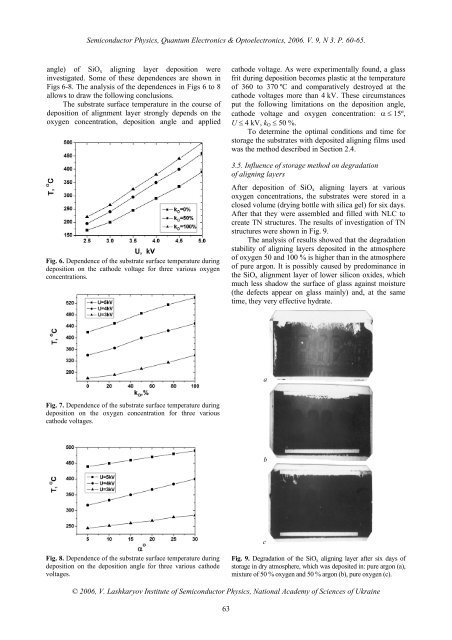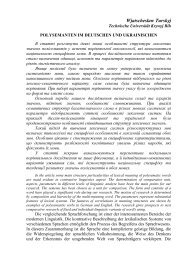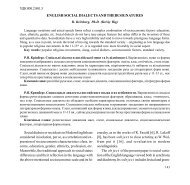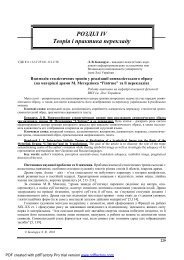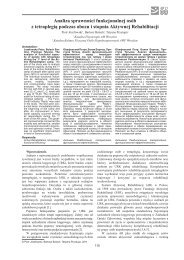Disappearance of aligning properties of deposited SiOx films as ...
Disappearance of aligning properties of deposited SiOx films as ...
Disappearance of aligning properties of deposited SiOx films as ...
Create successful ePaper yourself
Turn your PDF publications into a flip-book with our unique Google optimized e-Paper software.
Semiconductor Physics, Quantum Electronics & Optoelectronics, 2006. V. 9, N 3. P. 60-65.<br />
angle) <strong>of</strong> <strong>SiOx</strong> <strong>aligning</strong> layer deposition were<br />
investigated. Some <strong>of</strong> these dependences are shown in<br />
Figs 6-8. The analysis <strong>of</strong> the dependences in Figs 6 to 8<br />
allows to draw the following conclusions.<br />
The substrate surface temperature in the course <strong>of</strong><br />
deposition <strong>of</strong> alignment layer strongly depends on the<br />
oxygen concentration, deposition angle and applied<br />
Fig. 6. Dependence <strong>of</strong> the substrate surface temperature during<br />
deposition on the cathode voltage for three various oxygen<br />
concentrations.<br />
Fig. 7. Dependence <strong>of</strong> the substrate surface temperature during<br />
deposition on the oxygen concentration for three various<br />
cathode voltages.<br />
Fig. 8. Dependence <strong>of</strong> the substrate surface temperature during<br />
deposition on the deposition angle for three various cathode<br />
voltages.<br />
© 2006, V. L<strong>as</strong>hkaryov Institute <strong>of</strong> Semiconductor Physics, National Academy <strong>of</strong> Sciences <strong>of</strong> Ukraine<br />
63<br />
cathode voltage. As were experimentally found, a gl<strong>as</strong>s<br />
frit during deposition becomes pl<strong>as</strong>tic at the temperature<br />
<strong>of</strong> 360 to 370 ºC and comparatively destroyed at the<br />
cathode voltages more than 4 kV. These circumstances<br />
put the following limitations on the deposition angle,<br />
cathode voltage and oxygen concentration: α ≤ 15º,<br />
U ≤ 4 kV, kO ≤ 50 %.<br />
To determine the optimal conditions and time for<br />
storage the substrates with <strong>deposited</strong> <strong>aligning</strong> <strong>films</strong> used<br />
w<strong>as</strong> the method described in Section 2.4.<br />
3.5. Influence <strong>of</strong> storage method on degradation<br />
<strong>of</strong> <strong>aligning</strong> layers<br />
After deposition <strong>of</strong> <strong>SiOx</strong> <strong>aligning</strong> layers at various<br />
oxygen concentrations, the substrates were stored in a<br />
closed volume (drying bottle with silica gel) for six days.<br />
After that they were <strong>as</strong>sembled and filled with NLC to<br />
create TN structures. The results <strong>of</strong> investigation <strong>of</strong> TN<br />
structures were shown in Fig. 9.<br />
The analysis <strong>of</strong> results showed that the degradation<br />
stability <strong>of</strong> <strong>aligning</strong> layers <strong>deposited</strong> in the atmosphere<br />
<strong>of</strong> oxygen 50 and 100 % is higher than in the atmosphere<br />
<strong>of</strong> pure argon. It is possibly caused by predominance in<br />
the <strong>SiOx</strong> alignment layer <strong>of</strong> lower silicon oxides, which<br />
much less shadow the surface <strong>of</strong> gl<strong>as</strong>s against moisture<br />
(the defects appear on gl<strong>as</strong>s mainly) and, at the same<br />
time, they very effective hydrate.<br />
a<br />
b<br />
c<br />
Fig. 9. Degradation <strong>of</strong> the SiO х <strong>aligning</strong> layer after six days <strong>of</strong><br />
storage in dry atmosphere, which w<strong>as</strong> <strong>deposited</strong> in: pure argon (a),<br />
mixture <strong>of</strong> 50 % oxygen and 50 % argon (b), pure oxygen (c).


